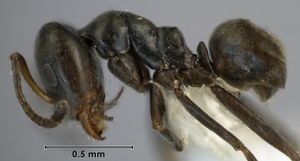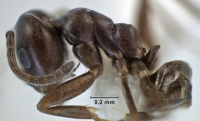Iridomyrmex difficilis
| Iridomyrmex difficilis | |
|---|---|

| |
| Scientific classification | |
| Kingdom: | Animalia |
| Phylum: | Arthropoda |
| Class: | Insecta |
| Order: | Hymenoptera |
| Family: | Formicidae |
| Subfamily: | Dolichoderinae |
| Tribe: | Leptomyrmecini |
| Genus: | Iridomyrmex |
| Species: | I. difficilis |
| Binomial name | |
| Iridomyrmex difficilis Heterick & Shattuck, 2011 | |
Iridomyrmex difficilis is a very widespread, relatively common species, and has been recorded from all the mainland Australian states as well as on islands in the Torres Strait and off the Queensland coastline. The species is capable of occupying a range of habitats, including rainforest, grassland, dry sclerophyll forest, acacia woodland and even paddocks, and is predominantly a ground forager that nests in soil. There is one series taken from a nest under a rock (Sevenhill, South Australia). While many, perhaps most records come from pitfall traps, specimens have also been collected by hand, from a berlesate and from sieved litter. Like many other Iridomyrmex, this species has been found tending the caterpillar of Jalmenus evagoras (Whiporie, New South Wales).
Identification
Iridomyrmex difficilis, as its name suggests, poses some taxonomic difficulties because of its bland yet variable morphology. Workers of southern populations tend to have a steeply ascending anterior pronotum and weakly truncate propodeum and often also have a few small setae on the posterior margin of the head and on the pronotum. Further north, workers tend to be glabrous with a strongly protuberant propodeum, while populations in the Torresian zone, also glabrous, often have only a moderately ascending pronotum and a truncate propodeum that may have a sharp or even slightly dentate propodeal angle. Intermediate forms that link the more distinctive phenotypes occur throughout the range of the species. Workers of this very small brown ant are most easily mistaken for small workers of Iridomyrmex mjobergi, which also have yellow mandibles. However, the antennal scape is always shorter in I. difficilis than in I. mjobergi, and, in full-face view, barely breaks the outline of the posterior margin of the head, if at all. The metanotal groove is also stronger in I. difficilis. Glabrous specimens with a strongly rounded and protuberant propodeum are very similar to Iridomyrmex gumnos, but the latter has a strongly concave posterior margin of the head in full-face view, and the antennal scape exceeds the posterior margin of the head by approximately twice its greatest diameter. The closest relative to I. difficilis is likely to be Iridomyrmex cyaneus, but that ant has an iridescence always lacking in I. difficilis.
Keys including this Species
Distribution
Latitudinal Distribution Pattern
Latitudinal Range: -10.75° to -35.81666565°.
| North Temperate |
North Subtropical |
Tropical | South Subtropical |
South Temperate |
- Source: AntMaps
Distribution based on Regional Taxon Lists
Australasian Region: Australia (type locality).
Distribution based on AntMaps
Distribution based on AntWeb specimens
Check data from AntWeb
Countries Occupied
| Number of countries occupied by this species based on AntWiki Regional Taxon Lists. In general, fewer countries occupied indicates a narrower range, while more countries indicates a more widespread species. |

|
Estimated Abundance
| Relative abundance based on number of AntMaps records per species (this species within the purple bar). Fewer records (to the left) indicates a less abundant/encountered species while more records (to the right) indicates more abundant/encountered species. |

|
Biology
Castes
Worker
  
| |
| . | |
Nomenclature
The following information is derived from Barry Bolton's Online Catalogue of the Ants of the World.
- difficilis. Iridomyrmex difficilis Heterick & Shattuck, 2011: 73, figs. 31, 95 (w.) AUSTRALIA.
Type Material
- Holotype, worker, 2km NNW Crossman, Western Australia, Australia, 32°45′0″S 116°34′0″E / 32.75°S 116.566667°E, 24 September 1981, I. D. Naumann & J. C. Cardale, ANIC32-042124, Australian National Insect Collection.
- Paratype, 3 workers, Mt Magnet area, Western Australia, Australia, 15 May 1967, C. T. Mercovich, ANIC32-032540, Ants Vial 63.233, Australian National Insect Collection.
- Paratype, 7 workers, Mt Magnet area, Western Australia, Australia, 15 May 1967, C. T. Mercovich, ANIC32-040017, Australian National Insect Collection.
- Paratype, 2 workers, Mt Magnet area, Western Australia, Australia, 15 May 1967, C. T. Mercovich, ANIC32-040017, Museum of Comparative Zoology.
- Paratype, 3 workers, 16km NNW Gibson, Western Australia, Australia, 33°31′0″S 121°43′0″E / 33.516667°S 121.716667°E, 17 November 1969, R. W. Taylor, Ants Vial 60.148, ANIC32-038317, Australian National Insect Collection.
Note: A syntype of Iridomyrmex mjobergi from the Kimberley district, Western Australia, examined by Heterick & Shattuck (2011) actually belongs to this species. With the designation of another I. mjobergi syntype (from the same locality) as the lectotype for I. mjobergi, this specimen loses its type status (ICZN, article 73.2.2), and hence its name bearing function. Since this specimen is badly mounted and its features are poorly displayed (though still recognizable on close inspection), a new and better quality pinned worker was chosen as a holotype to represent I. difficilis.
Description
Worker Description. Head. Posterior margin of head weakly concave; erect setae on posterior margin in full- face view, present singly or as a couple of setae on either side of posterior margin of head, or absent; sides of head noticeably convex; erect genal setae absent from sides of head in full-face view (one to a few small setae may be present near mandibular insertion). Ocelli absent; in full-face view, eyes set at about midpoint of head capsule; in profile, eye set anteriad of head capsule; eye asymmetrical, curvature of inner eye margin more pronounced than that of its outer margin. Frontal carinae straight; antennal scape barely attaining posterior margin of head, or surpassing it by less than 1 x its diameter. Erect setae on scape absent, except at tip; prominence on anteromedial clypeal margin present as an indistinct swelling or undulation; mandible triangular with distinct angle between masticatory and basal margins; long, curved setae on venter of head capsule absent. Mesosoma. pronotum strongly inclined anteriorly. Erect pronotal setae sparse to absent. Mesonotum straight, or evenly curved. Mesothoracic spiracles always inconspicuous; propodeal dorsum protuberant, or straight and short (equal in length to propodeal declivity); placement of propodeal spiracle posteriad and near propodeal declivity; propodeal angle present as sharply defined angle, the dorsal and declivitous propodeal faces often separated by a carina, or present as a bluntly defined right angle, the dorsal and declivitous propodeal faces never separated by a carina. Erect propodeal setae lacking or very minute (one or two tiny setae present). Petiole. Dorsum of node acuminate, or convex; node thin, scale-like, orientation more-or-less vertical. Gaster. Non-marginal erect setae of gaster present or absent on first gastral tergite; marginal erect setae of gaster present on first tergite, or absent on first tergite. General characters. Allometric differences between workers of same nest absent. Colour uniformly medium to blackish-brown. Colour of erect setae whitish.
Measurements. Worker (n = 9)—CI 85–92; EI 24–30; EL 0.13–0.16; EW 0.10–0.12; HFL 0.49–0.67; HL 0.55–0.68; HW 0.48–0.60; ML 0.57–0.78; MTL 0.36–0.49; PpH 0.08–0.12; PpL 0.26–0.36; SI 85–94; SL 0.44– 0.54.
Etymology
Latin meaning ‘troublesome’ or ‘difficult’.
References
- Heterick, B.E. & Shattuck, S.O. 2011. Revision of the ant genus Iridomyrmex (Hymenoptera: Formicidae). Zootaxa 2845: 1-175.
- Heterick, B.E. 2022. A guide to the ants of Western Australia. Part II: Distribution and biology. Records of the Western Australian Museum, supplement 86: 247-510 (doi:10.18195/issn.0313-122x.86.2022.247-510).
References based on Global Ant Biodiversity Informatics
- Fisher J., L. Beames, B. J. Rangers, N. N. Rangers, J. Majer, and B. Heterick. 2014. Using ants to monitor changes within and surrounding the endangered Monsoon Vine Thickets of the tropical Dampier Peninsula, north Western Australia. Forest Ecology and Management 318: 7890.
- Heterick B. E., and S. Shattuck. 2011. Revision of the ant genus Iridomyrmex (Hymenoptera: Formicidae). Zootaxa 2845: 1-174.

